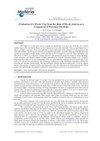Investigation of sustainable porous carbon as radar absorbing material
IF 0.5
4区 材料科学
Q4 MATERIALS SCIENCE, MULTIDISCIPLINARY
引用次数: 3
Abstract
Radar Absorbing Materials (RAMs) are composite materials able to attenuate an incident electromagnetic wave. Usually, RAMs are made of a polymeric matrix and an electromagnetic absorbent filler, such as silicon carbide or carbon black. Several materials have been investigated as potential fillers, aiming to improve the Reflection Loss (RL) and absorption bandwidth broadening. In this paper, a composite made with silicone rubber and biochar was investigated as a sustainable porous carbon made with biomass waste. Five different composites were characterized, composed of 1 - 5 wt.% of biochar in the silicone rubber. Although the RL of pure biochar composites is not significant, it was demonstrated here how a biochar composite can improve the RL of a RAM material when it is applied as a double-layer structure. While the RL of a ferrite-based RAM with 2.0 mm thickness reaches -28 dB, a combination of this RAM with biochar composite reaches ~ -60 dB with the same thickness. The double-layer structure with 2.3 mm thickness can have an absorption bandwidth of 2.95 GHz over the X-band frequency range, and a structure with 2.6 mm thickness can reach a RL of ~-76 dB. This demonstrates a sustainable, cheaper, and lighter material application (i.e., biochar), which is successfully used in the development of high-efficient electromagnetic shield or sensors. Keywords: Biochar, permittivity, RAM, sustainability, reflectivity.可持续多孔碳雷达吸波材料的研究
雷达吸波材料是一种能够衰减入射电磁波的复合材料。通常,ram由聚合物基体和电磁吸收填料(如碳化硅或炭黑)制成。研究了几种材料作为潜在的填料,旨在改善反射损耗(RL)和吸收带宽的拓宽。本文研究了硅橡胶与生物炭复合材料作为生物质废弃物制备的可持续多孔炭。在硅橡胶中加入1 ~ 5%的生物炭,对五种不同的复合材料进行了表征。虽然纯生物炭复合材料的RL并不显著,但本文展示了生物炭复合材料作为双层结构应用时如何提高RAM材料的RL。厚度为2.0 mm的铁氧体基RAM的RL可达-28 dB,而相同厚度的铁氧体基RAM与生物炭复合材料的RL可达~ -60 dB。厚度为2.3 mm的双层结构在x波段频率范围内的吸收带宽为2.95 GHz,厚度为2.6 mm的双层结构的RL可达~-76 dB。这展示了一种可持续的、更便宜的、更轻的材料应用(即生物炭),它成功地用于开发高效的电磁屏蔽或传感器。关键词:生物炭,介电常数,RAM,可持续性,反射率。
本文章由计算机程序翻译,如有差异,请以英文原文为准。
求助全文
约1分钟内获得全文
求助全文
来源期刊

Materia-rio De Janeiro
MATERIALS SCIENCE, MULTIDISCIPLINARY-
CiteScore
1.00
自引率
25.00%
发文量
51
审稿时长
6 weeks
期刊介绍:
All the articles are submitted to a careful peer-reviewing evaluation process by the journal''s Editorial Board. The Editorial Board, reviewers and authors make use of a web based proprietary automated tool to deal with the reviewing procedures.the Revista Matéria''s article reviewing restricted access system - SEER. Authors are not informed about the identity of the reviewers.
 求助内容:
求助内容: 应助结果提醒方式:
应助结果提醒方式:


